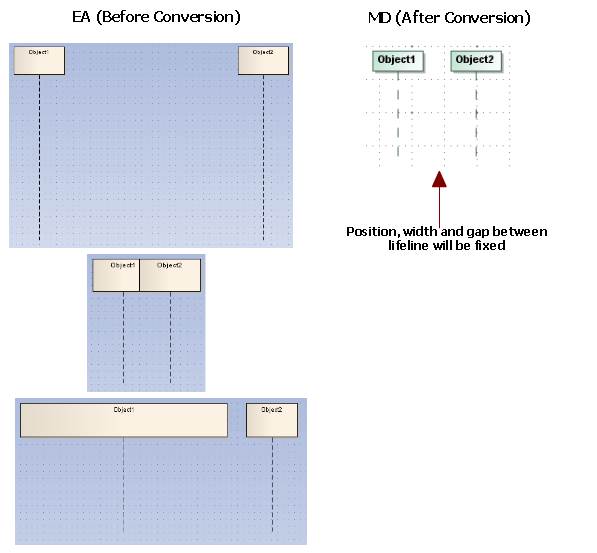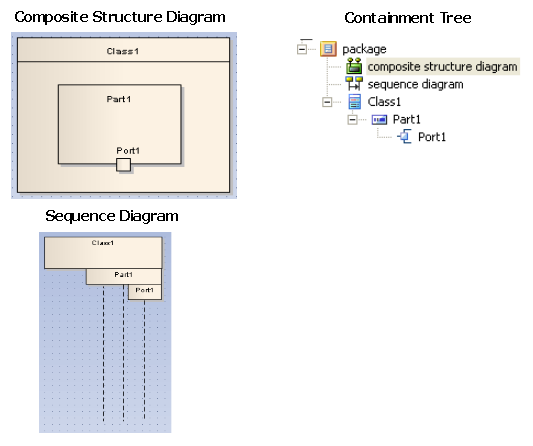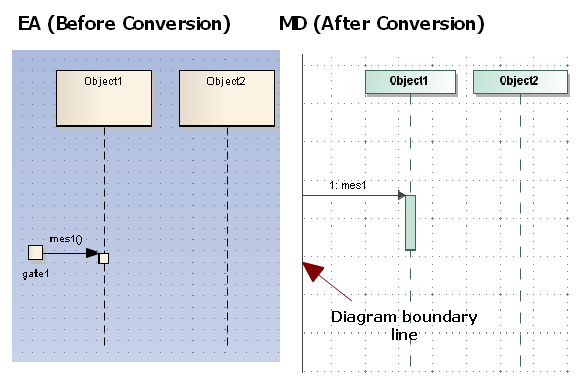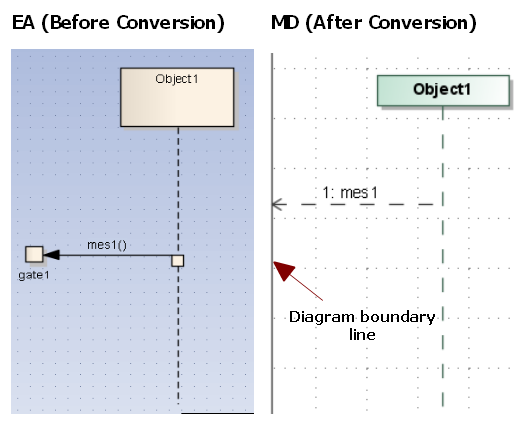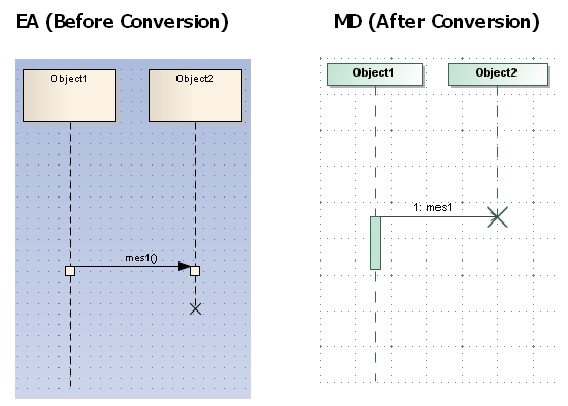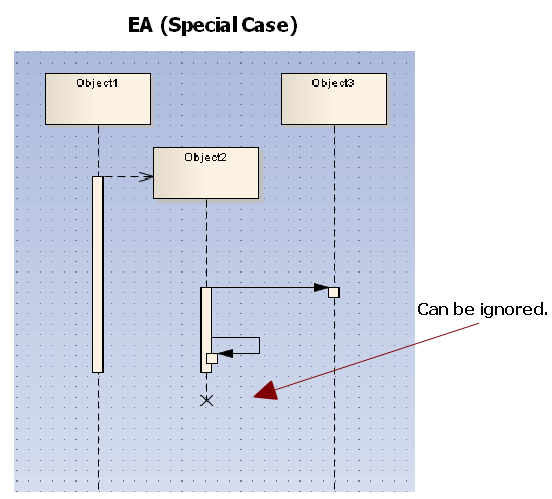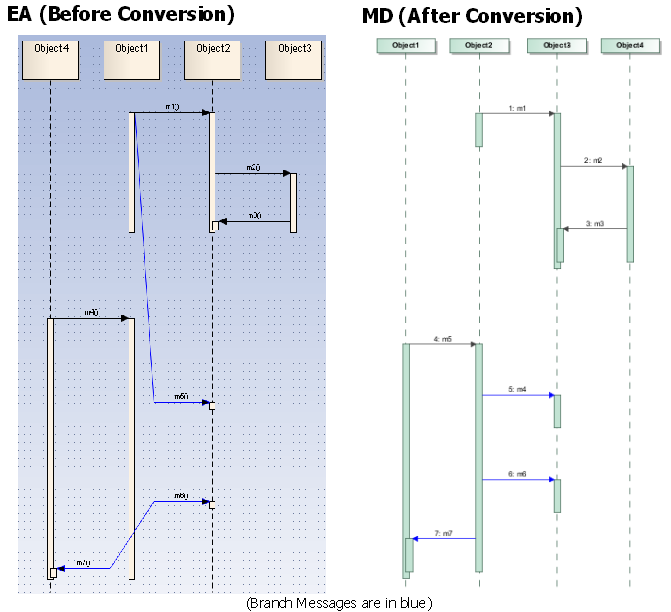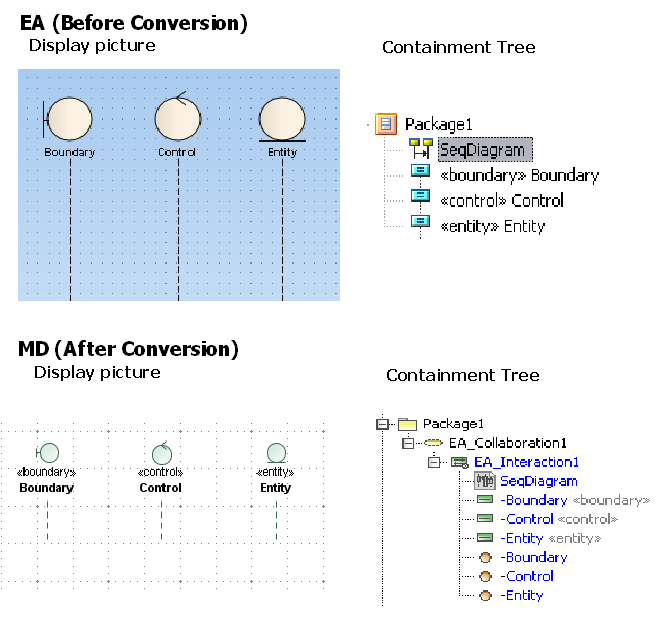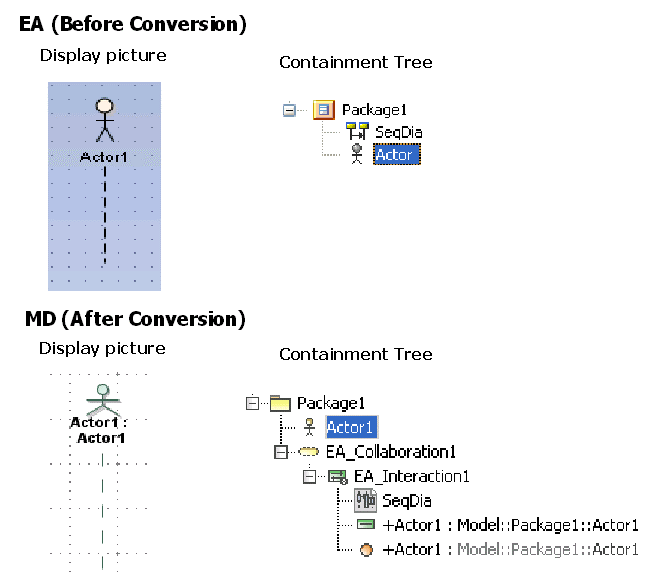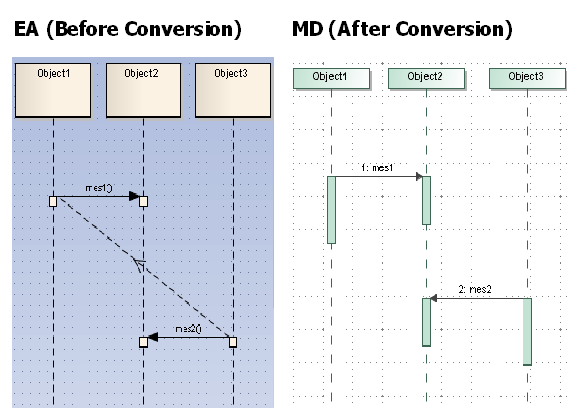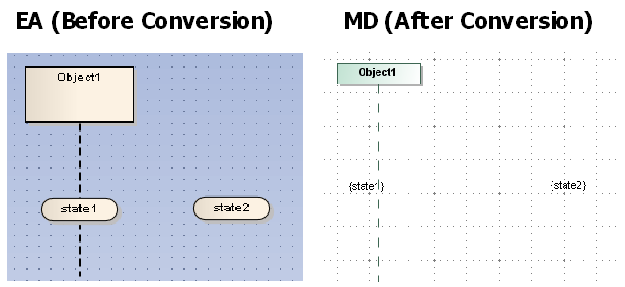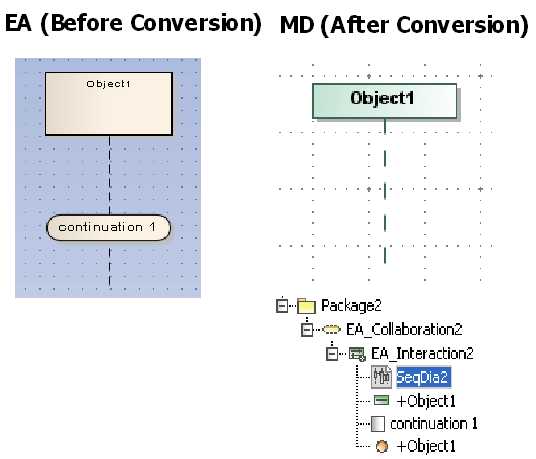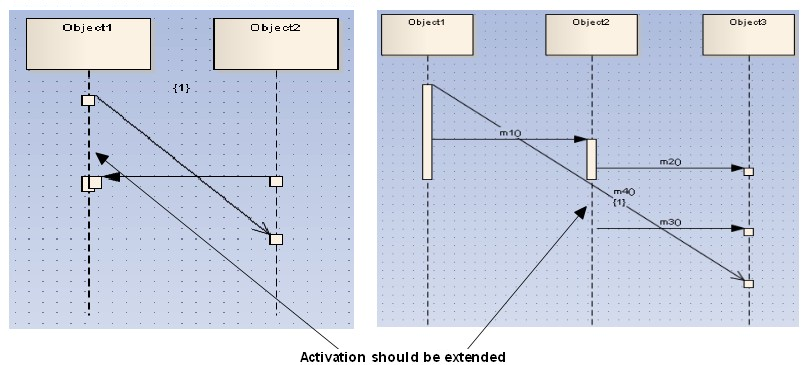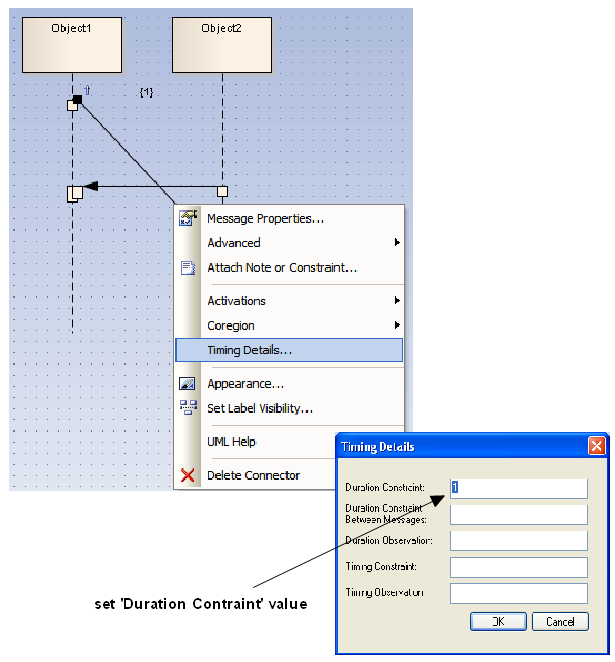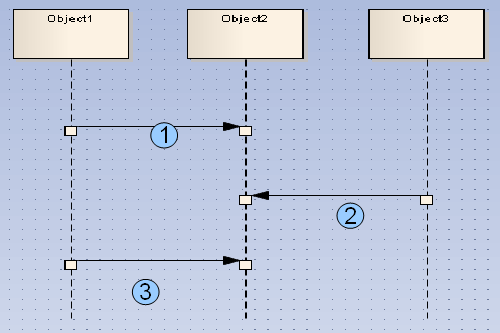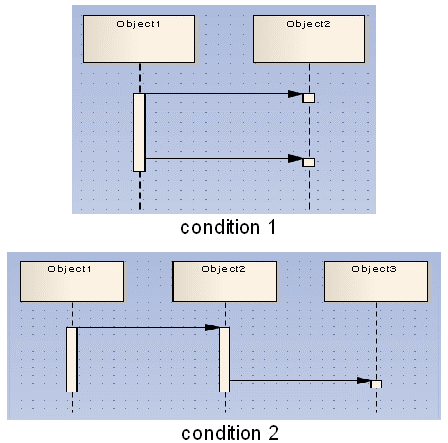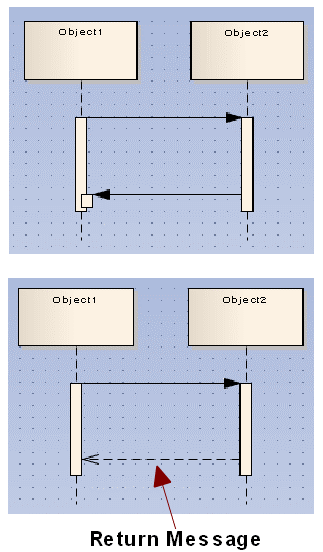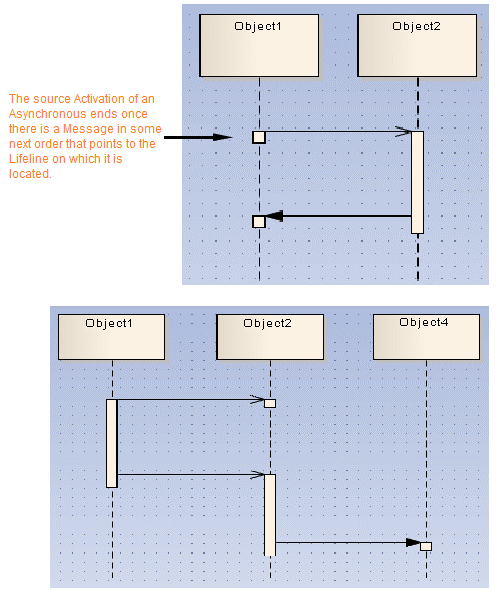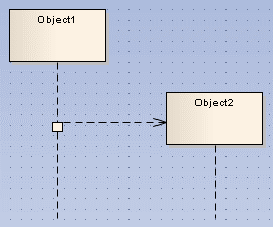On this page
Lifelines
All of the EA Lifelines will be imported, but a part or port within a Lifeline will be transformed into a new separate Lifeline.
Gaps between Lifelines
The position and width of any Lifeline created in EA will not be imported. Every Lifeline will be given a fixed value and position in MagicDraw, CEA, or CSM. MagicDraw, CEA, or CSM will place the first Lifeline on the left-hand side of the diagram and the second Lifeline on the right-hand side next to the first one. The length of the gap between the Lifelines will be fixed.
Gaps between Lifelines.
Lifelines Arrangement
A Lifeline can be nested within another component, such as a Part or Port. If this is the case, every component nested within the Lifeline and the Lifeline itself will be drawn separately. They will be arranged in order depending on the position of their Lifeline lines.
Lifelines arrangement.
Class, Part, and Port
When represented as Lifelines, Classes, Parts, and Ports have different characteristics from the others. They will be bundled according to their relationships. A Composite Structure diagram provides one convenient way to create a Class, Part, or Port.
Class, Part, and Port.
Gate
A Sequence Message whose tail is connected to a Gate and head connected to a Lifeline in EA will be transformed into a Sequence Message with its tail connected to one of the boundary lines of the diagram in which it is contained. The Gate itself will be removed.
Gate.
Once the Gate has been removed and the transformation process has been completed, the following transformation message will open:
Removed element <xmi:id>: uml:Gate.
A Sequence Message whose head is connected to a Gate and tail connected to a Lifeline line in EA will be transformed into a Reply Message with its tail connected to one of the boundary lines of the diagram in which it is contained. The Gate itself will be removed
Gate (EA) and Reply Message (MagicDraw, CEA, or CSM).
The Diagonal Message and Reply Message will be connected to the nearest diagram boundary.
Gate (EA) and Direction of Diagonal Message (MagicDraw, CEA, or CSM).
Anything else connected to a Gate will also be removed, except the tail of a Sequence Message. For example, if the head of a Sequence Message is connected to a Gate, the Message will be removed. If the tail of a Message is connected to a Gate, but the head is connected to anything other than a Lifeline line, the Message will be removed.
Endpoints
A Sequence Message whose head connected to an Endpoint and tail connected to a Lifeline line in EA will be transformed into a Lost Message. The Endpoint element itself will be removed. Once the process has been completed, the following transformation message will open:
Removed element <xmi:id>: EndPoint.
A Message whose head connected to a Lifeline line and tail connected to an Endpoint will be transformed into a Found Message.
Endpoint.
Anything else connected to an endpoint will also be removed, except the head of a Sequence Message. For example, if the tail of a Sequence Message is connected to an endpoint, the Message will be removed.
If the head of a Message is connected to an endpoint, but the tail is connected to anything other than a Lifeline line, the Message will be removed. Once the process has been completed, the following transformation message will open:
Removed element <xmi:id>: Invalid Message. Source and Target of the Mes- sage are not connected to any Lifeline.
Delete Messages
A Sequence Message whose property Lifecycle is set to Delete (that causes the Lifeline targeted by the Message to end at some range after the point of contact), will be transformed into a Delete Message. The Lifeline connected to its head will end at the point of contact, and all Messages will be removed after that point of contact of the Lifeline. MagicDraw, CEA, or CSM will report the following transformation message once each process has been completed:
Removed element <xmi:id>: Message is under Delete Message.
Delete message.
Under certain circumstances, a Lifeline connected to the head of a Delete Message does not end at the point of contact. Instead, an Activation will be created and started from the point of contact. The Lifeline will then end at the end of the Activation. However, that Activation should not interact with any Message.
Special case of delete message.
Under certain circumstances, an X sign (normally drawn after a Delete Message) in EA will be drawn on a Lifeline line whose Lifeline is being pointed by a Create Message. If this is the case, the X sign has no significant meaning and can be ignored.
The X sign.
Branch Messages
If the Branch with previous Message option of a Sequence Message is enabled, the tail of the message connect to the tail of its previous Message on the same Lifeline line. The message will be called Branch Message from that time on.
Every Branch Message in EA will be transformed into a normal Message in MagicDraw, CEA, or CSM.
Branch Message.
After the transformation process has been completed, the following transformation message will open:
Updated element <xmi:id>: Branch Message updated to regular Message.
Boundaries, Controls, and Entities
The Boundary, Control, and Entity elements in a Sequence diagram context in EA are Lifeline elements whose stereotype property types are set to Boundary, Control, or Entity. They will be imported like any other normal Lifelines. However, an XMI exported from EA has an «entity» stereotype problem. This means the Lifeline with the «entity» stereotype applied is unable to show the stereotype icon. You can solve this problem by placing an «entity» stereotype in EA_Profile.xml. The converted model can then use it instead of the one from EA.
Boundary, Control, and Entity.
Actors
An Actor element in the Sequence diagram context in EA is not a regular Lifeline element. It is a special Lifeline element whose property type is uml:Actor. It will be transformed into a regular Actor and a Lifeline element will be created to represent it. The figure below shows an Actor element in the MagicDraw, CEA, or CSM Containment tree.
Actor.
General Ordering
Not every General Ordering element in EA will be imported, as MagicDraw, CEA, or CSM does not support it in the current release.
General ordering.
After completing the transformation process, the following transformation message will open:
Updated element <xmi:id>: General Ordering will not be imported.
State Invariant
A State Invariant in EA will be transformed as is. MagicDraw, CEA, or CSM does not support State Invariants in the current release.
State Invariant.
Continuation
Continuations from EA can be imported to MagicDraw, CEA, or CSM. They are viewable in the Containment Tree, but without a picture displayed in the diagram. MagicDraw, CEA, or CSM does not support Continuations in the current release.
Continuation.
After completing the transformation process, the following transformation message will open:
Updated element <xmi:id>: Continuation will not be displayed.
Diagonal Message
A Diagonal Message is a Message whose destination's height is adjustable. A diagonal Message may change Activations.
To create a Diagonal Message in EA, you must specify the Timing Details property of the Message and add a numeric value to the Duration Constraint input field.
Creating a Diagonal Message.
Synchronous Message behavior
The placement of Synchronous Messages in EA affects the way Activations are created.
Order
A Message in EA has a Sequence Number that indicates the order of the message in the diagram. This information can be found in the exported XMI file. Knowing it helps predict how Activations will be created. The order starts from the top and goes downward, so the first Message in the diagram is the one drawn at the top of the diagram. Its Sequence Number will be set to '1'.
Message sequence number.
Process
Generally, in EA, any two Synchronous Messages will be in the same process if they meet the following conditions:
- Both of their tails are placed on the same Lifeline.
- The head of the upper Message and the tail of the lower Message are on the same Lifeline.
Process.
Activation level
The Activation Level starts from level 0. It will increase in increments of 1 as an ongoing process that receives a Message that is not a Return Message (Reply Message in MagicDraw, CEA, or CSM).
Activation level.
Asynchronous Message behavior
If a Message is an Asynchronous Message in EA, its source Activation will end if there is no other Message in the same group with a higher Sequence Number. Its source will be attached to the same Lifeline.
Asynchronous Message.
Return Message behavior
A Return Message in EA is called a Reply Message in MagicDraw, CEA, or CSM. When it is pointed to an Activation, it will not create an Activation at the top of the existing Activation, unlike other normal Synchronous Messages.
Return message.
Activation options
You can control how Activations behave at some level through the Message options. You can access Message options by right-clicking any Message, and then selecting the Activations option. However, MagicDraw, CEA, or CSM does not support Activation options in the current release.
Activation options.
Related pages
